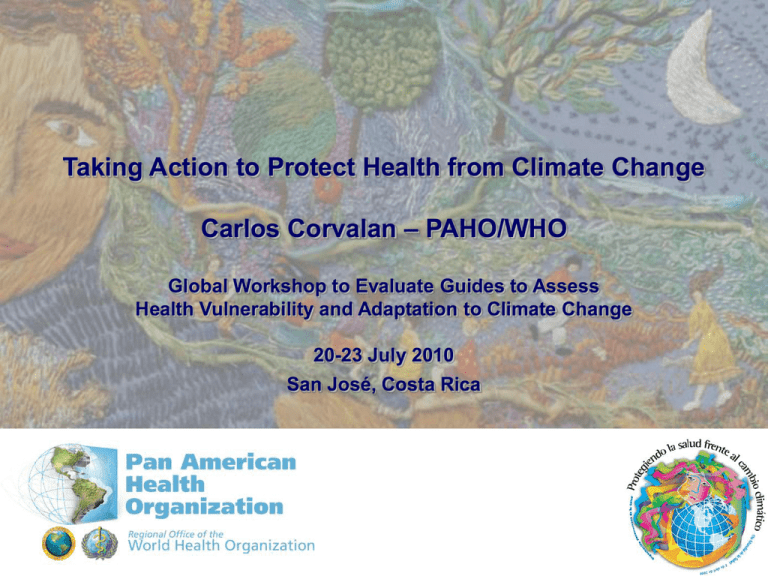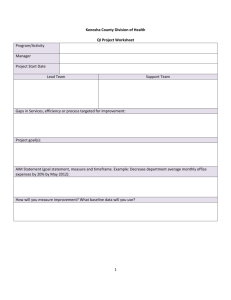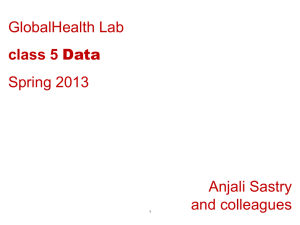Taking Action to Protect Health from Climate Change – PAHO/WHO Carlos Corvalan
advertisement

Taking Action to Protect Health from Climate Change Carlos Corvalan – PAHO/WHO Global Workshop to Evaluate Guides to Assess Health Vulnerability and Adaptation to Climate Change 20-23 July 2010 San José, Costa Rica Taking Action to Protect Health from Climate Change Carlos Corvalan – PAHO/WHO Global Workshop to Evaluate Guides to Assess Health Vulnerability and Adaptation to Climate Change 20-23 July 2010 San José, Costa Rica Basic concepts The Climate Change challenge An agenda for action What constitutes Health? Physical, mental health? Social well-being? Everything? What constitutes the environment? Physical, Chemical, Biological agents? Social, cultural environment? Everything? What is Environmental Health? It also refers to the Environmental health refers theory and practice to those aspects of human of assessing and controlling health or disease which environmental factors which can are determined by harm human health, or promoting environmental those which protect health factors Cardiovasc. diseases Environment-society-individual interaction on health Cancer Diabetes Physical inactivity Respiratory diseases Causes of the causes Migration Transport EnergyLung cancer Direct causes Radiation Injuries Chemicals Climate change Malaria Cardiovasc. diseases Respiratory infections COPD Air pollution Degraded ecosystems Health Diarrhoea Injuries etc. Desertification Malnutrition Water, sanitation Cardiovasc. diseases Vector breeding sites Water Intestinal scarcity parasites Diarrhoea Drownings Malnutrition etc. Malaria Dengue Leishmaniasis etc. Global inequalities: GNI versus EBD Env.DALYs/1000 capita per year 350 Sierra Leone Angola 300 250 Guinea-Bissau 200 Mozambique China 150 India 100 Brazil Finland Iceland USA 30000 35000 50 0 5000 10000 Afro Amro Emro Euro Searo Wpro 15000 20000 25000 GNI per capita [US$] 40000 Basic concepts The Climate Change challenge An agenda for action Climate change impacts on other risk factors Causes of the causes Migration Energy Transport Proximal causes Radiation Chemicals Climate change Air pollution Degraded ecosystems Health Water, sanitation Vector breeding sites Water scarcity Desertification The health effects of climate change Climate change produce local health impacts and increase inequalities Climate change begins with… the most vulnerable groups: Children under 5; Pregnant women; Elderly people; Marginalized rural, urban and indigenous populations; Displazed persons The most vulnerable to environmental changes are the least responsible for their cause Climate change: children are the worst affected 88% of the burden of disease attributable to climate change affects children under 5 climate change begins with… the most vulnerable regions: With high transmission of climate sensitive diseases; Low food production; Water scarcity; Island and coastal cities Mountain communities Climate change begins with… the most important public health problems: Communicable diseases; Food security; Disaster risks Water quality and access Disease vectors Many of the major killers are climate sensitive - Each year: - Undernutrition kills 3.5 million - Diarrhoea kills 2.2 million - Malaria kills over 900 thousand Each of these is highly sensitive to temperature and precipitation Basic concepts The Climate Change challenge An agenda for action Global Workplan for addressing the implications of climate change for health and health systems Workplan Aims: • Support health systems in all countries, in order to enhance capacity for assessing and monitoring health vulnerability, risks and impacts due to climate change; • Identify strategies and actions to protect human health, particularly of the most vulnerable groups; and • Share knowledge and good practices. Strengthen health systems Global Workplan Objectives Evidence Addressing the implications of climate change for health Partnerships Raising awareness Workplan Objectives: 1. Raising awareness of the effects of climate change on health, in order to prompt action for public health measures. 2. Engage in partnerships with other United Nations organizations and sectors other than the health sector at national, regional and international levels, in order to ensure that health protection and health promotion are central to climate change adaptation and mitigation policies 3. Promote and support the generation of scientific evidence 4. Strengthen health systems to cope with the health threats posed by climate change, including emergencies related to extreme weather events and sea-level rise Actions from the local to the global setting We have only one Mother Earth




